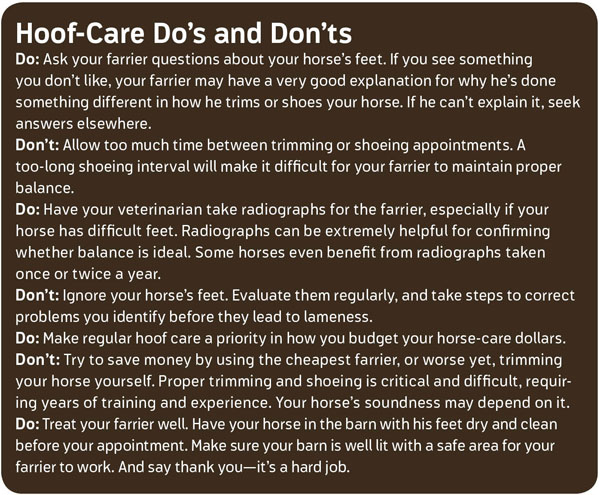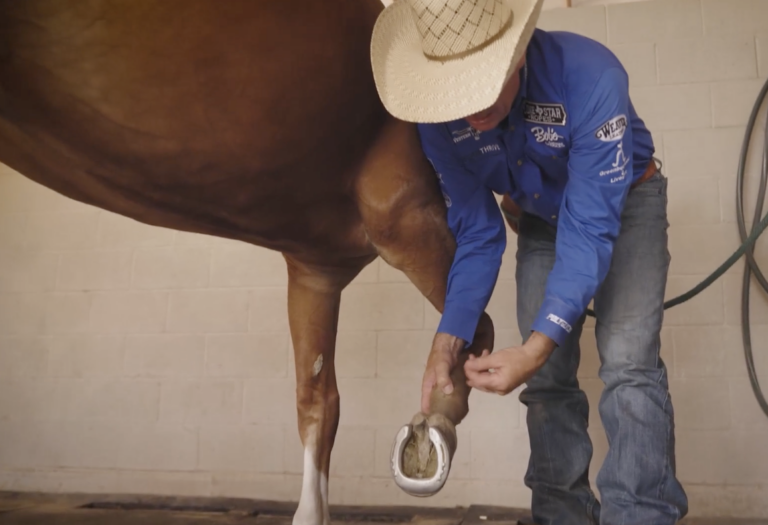I was called to do a lameness exam. “My mare’s just not right,” my client told me. “One day she’ll seem fine, and the next she’s downright lame. Sometimes it seems like the right front, other days it’s the left. Most of the time she just comes out stiff and gets better after I warm her up. It’s been going on for months. What could be wrong?”
[READ: 7 Worst Mistakes in Horse Hoof Care]
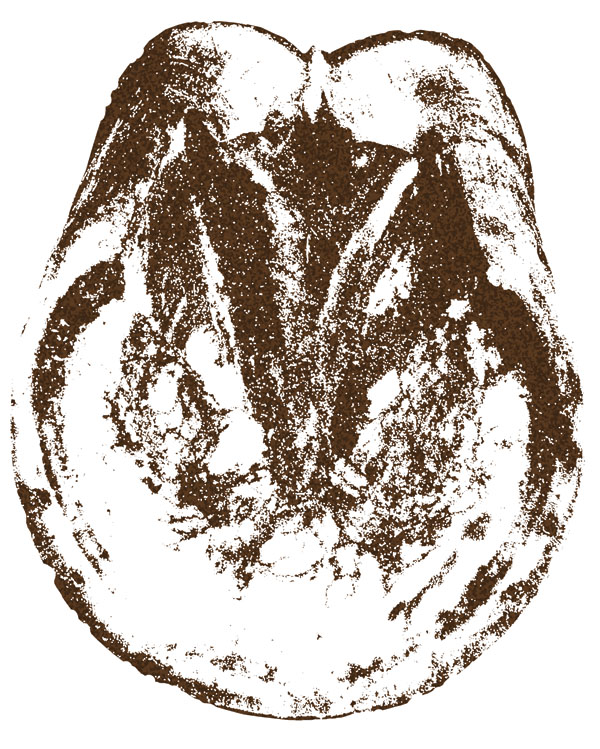
One look at the poor horse standing in the barn aisle, and I already had a pretty good handle on the problem. “Her toes are really long,” I commented, “and see how her heels are drawn forward under the back of her shoe? When was she last shod?” I wasn’t surprised to learn that it had been 10 weeks since she last saw the farrier.
By the end of my exam, we’d confirmed that the mare was extremely sore in both front feet, and didn’t have any significant problems on radiographs other than terrible hoof balance. In fact, her 10-week interval between farrier appointments may have been the primary underlying cause of her frustrating, intermittent lameness.
So how did I know that her feet were the problem before I ever saw her take a step? Simple observation of those long toes and crushed heels was all it took to tell me that her feet were likely to be killing her. And sure enough, with some careful adjustments and a shortened interval between farrier visits, that chronic lameness problem became a distant memory.

While it’s fairly easy to see obvious hoof problems, such as distortion, cracks, or rings, balance problems can be much more subtle. Here, I’m going to give you the tools you need to read between the lines when looking at your horse’s feet. I’ll explain what a “perfect foot” should look like, and will outline a five-point foot check you can use to evaluate basic foot balance. With this information in hand, you’ll be able to tell if your horse’s feet are happy, or when trouble might be brewing.
The Balanced Foot: Art, Not Science Your horse’s entire bodyweight is suspended over his four relatively small hooves. And on those hooves he runs, jumps, and makes his way along the trail. For your horse to stay sound, his feet must function properly to provide cushioning, traction, and easy movement.
“Foot balance” is a common term. But what does it really mean? Unfortunately, the answer isn’t quite as simple as it seems. Does it mean the foot is perfectly symmetrical? That it’s shaped with ideal angles measured by a farrier’s tool? Or that it has a specific landing pattern when it hits the ground? It depends. While all these concepts enter into the equation, a balanced foot will vary with each individual horse—and that’s what’s most important.
Hoof balance really means that the hoof is trimmed and/or shod for an equal distribution of the horse’s weight over the entire foot, and for minimum stress to joints and soft-tissue structures when the horse takes a step. A skilled farrier will “balance” the foot based on the horse’s conformation, natural hoof shape, and pattern of movement.
5-Point Foot Check
When you see your horse standing in the barn aisle, you can evaluate hoof balance by looking at the five following points, all easily visible.
Point 1: Hoof- pastern axis
What it is: When viewing your horse from the side with his cannon bone perpendicular to the ground, you should be able to draw a straight line through the middle of the pastern and the hoof.

Why it matters: When your horse’s hoof-pastern axis is well aligned, the foot is oriented to most efficiently absorb and distribute stress. If the hoof-pastern axis is “broken forward” (the foot is upright compared to the pastern), the tip of your horse’s coffin bone will be stressed at landing, and his coffin joint is likely to get sore. If the hoof-pastern axis is “broken back” (the foot is low compared with the pastern), the structures in your horse’s heels will be stressed, including the all-important navicular bone, navicular bursa, and the attachment of the deep digital flexor tendon.
Point 2: Center of articulation
What it is: The “center of articulation” refers to the midpoint of the coffin joint—the joint between the hoof-shaped coffin bone encased within the hoof and the short pastern bone above it. This is the pivot point that the coffin joint should flex and extend around. In an ideal foot, a line drawn down through the center of the pastern to the coronary band should land so that a line drawn perpendicular from that point to the ground is at the center of the hoof. This places the bulk of your horse’s weight over the center of his coffin joint.

Why it matters: For your horse’s foot to work most efficiently, his weight should be centered over his legs and feet. If your line lands behind the foot, shock-absorbing structures and flexor tendons will be excessively stressed, and breakover (the effort required to lift the foot off the ground after it lands) will be more difficult. If the line lands toward the front of the foot, your horse’s toe will experience more concussion on landing, his coffin joint will be stressed, and his foot won’t function properly.
Point 3: Centering of the hoof
What it is: In an ideal foot, a line drawn across the widest part of the hoof should divide the foot approximately in half.
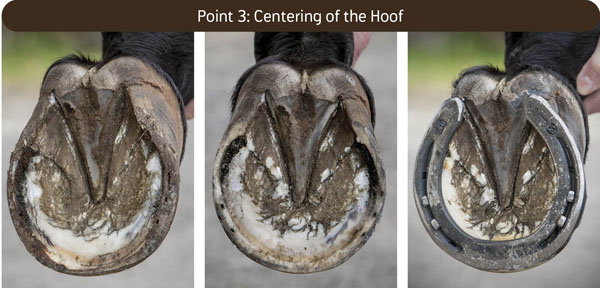
Why it matters: This widest point of the hoof usually coincides with the center of articulation of the coffin joint. It’s also the functional pivot point of the foot during breakover. In a perfectly balanced foot, these two pivot points will match. If the toe is excessively long, it acts like a lever arm, making it harder for the heel to rotate over the toe. If it’s too short, the tip of the coffin bone will be stressed. In either case, the coffin joint will undergo additional stress.
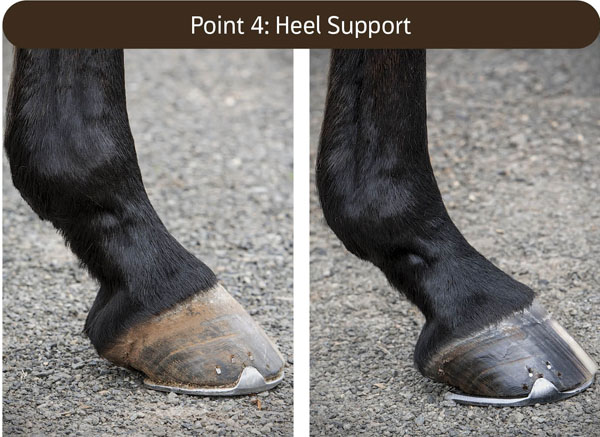
Point 4: Heel support
What it is: Your horse’s hoof grows at the same angle from the coronary band at both the toe and heel. Straight lines drawn from the coronary band to the toe, and coronary band to the heel, should be parallel to one another.
Why it matters: If the heel angle is significantly lower than the toe angle, your horse’s heels are “under run,” a certain sign of danger.
The horn tubules will begin to crush and flatten. Eventually, they’ll curl in on one another, causing the heel to completely lose its ability to bear weight, expand, or function properly. Bruised heels or stress to underlying structures such as the navicular bone and bursa can lead to chronic lameness.
Point 5: Frog proportions
What it is:In a perfect foot, the width of your horse’s frog at its base should be at approximately two-thirds of its length.
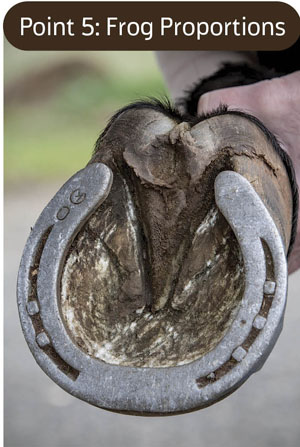
Why it matters: When your horse’s foot hits the ground, his heel expands to help cushion and distribute stresses. Expansion and contraction of structures beneath the heel also play a role in regulating blood flow to the feet. If your horse’s frog is long and skinny, his heels may not be expanding and contracting properly when he moves.
Although you may not be able to change the shape of your horse’s frog (or if you do, it’ll happen very slowly), this trait will alert you to potential problems that should be addressed. These include long toes or poor heel support.
[READ: Hoof Care Makes the Horse]
An Inside Look
The five-point foot check I’ve described gives you a system you can use to evaluate your horse’s foot balance. But it may not tell the whole story. Radiographs can be extremely useful, and even necessary, for helping to assess hoof balance. They give your vet and farrier an inside look at the actual alignment of the bones and their relationship to the hoof capsule. If you don’t like what you see after a five-point foot check, ask your farrier if he thinks radiographs would help him do his job. He’s likely to thank you. And if he could, so would your horse! Think of the cost as an investment in soundness.
